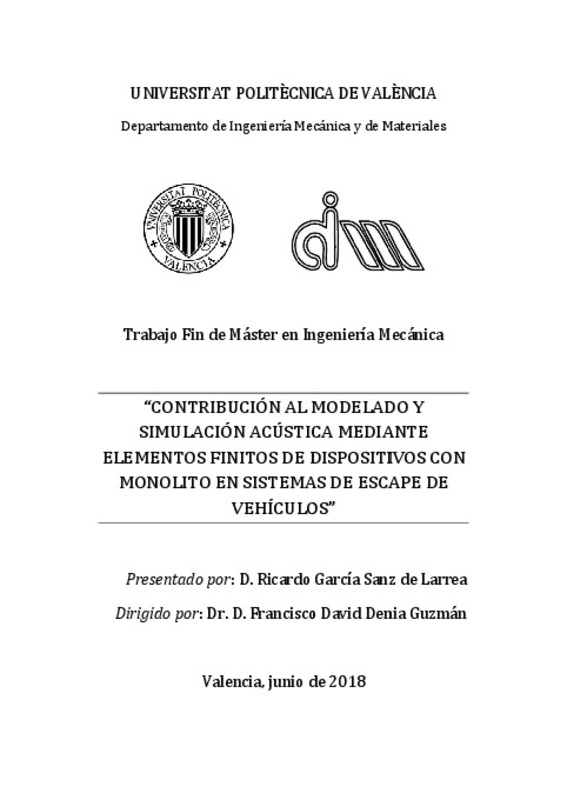|
Resumen:
|
Este Trabajo Fin de Máster está orientado en el ámbito de la acústica, centrándose en las prestaciones de atenuación sonora de la línea de escape de los vehículos equipados con motores de combustión interna alternativos, ...[+]
Este Trabajo Fin de Máster está orientado en el ámbito de la acústica, centrándose en las prestaciones de atenuación sonora de la línea de escape de los vehículos equipados con motores de combustión interna alternativos, concretamente en el comportamiento del catalizador. Para conseguir la información necesaria y poder realizar un estudio detallado y completo, se va a emplear el programa de elementos finitos Comsol Multiphysics. Aunque el catalizador no tiene como misión principal atenuar el ruido producido por el vehículo, juega un papel importante y más en el ámbito de automoción en el que se aplica una mejora continua de todos los elementos que componen el vehículo.
Los modelos que se van a plantear deben tener la capacidad de poder modificar parámetros tales como la posición de los conductos de la entrada y la salida del catalizador respecto al propio monolito y también de cambiar parámetros de las propiedades del monolito como puede ser su resistividad, además de acoplar dominios de aire y de monolitos cerámicos. Con todo ello, se van a comparar varios modelos entre sí para estudiar y comprender cómo influyen estos parámetros en la atenuación acústica.
En este trabajo se presentan inicialmente los fundamentos teóricos relativos a la teoría acústica, que se utilizarán posteriormente para determinar las prestaciones en cuanto a atenuación sonora de catalizadores. Se detallan dos metodologías de modelado del monolito, denominadas 3D3D y 3D1D.
La primera de ellas considera propagación de ondas 3D tanto en los conductos como en los capilares del monolito. La segunda, más realista, retiene el comportamiento 3D en los conductos, pero asume propagación 1D en los capilares, lo cual es más consistente con su geometría, de gran longitud respecto a su sección transversal. Se define la metodología de trabajo completa en el software Comsol Multiphysics, con gran nivel de detalle en todas sus etapas y se aplica a numerosos casos de interés práctico. El trabajo finaliza con un análisis de resultados y las conclusiones más relevantes.
[-]
This current final work of master is oriented in the field of acoustics, focusing on sound attenuation performance of the exhaust line of vehicles which work with iternative internal combustion engines, specifically on the ...[+]
This current final work of master is oriented in the field of acoustics, focusing on sound attenuation performance of the exhaust line of vehicles which work with iternative internal combustion engines, specifically on the behavior of the catalyst. In order to get the necessary information to be able to carry out a detailed and entire study, we are going to use the Comsol Multiphysics finite element program. Although the catalyst does not have as main tarjet reduces the noise produced by the engine, it plays a very important role especially in the automobile industry in which a continuous improvement of all the elements that make up the vehicle is applied.
The models that we are going to be studied must be able to modify parameters such as the position of the inlet and the outlet ducts of the catalyst with respect to the monolith itself, to change the properties of the monolith, such as its resistivity and as well to coupling air domains and ceramic monoliths. With all of them, several models are going to be compared among them to study and understand how these parameters influence in the acoustic attention.
This final work of master presents initially the theoretical foundations related to the acoustic theory, which will be used later to determine the performance in terms of sound attenuation of catalysts. There are two methodologies in order to model the monolith, called 3D3D and 3D1D.
The first of them considers the propagation of 3D waves both in the conduits and in the capillaries of the monolith. The second, more realistic, retains the 3D behavior in the conduits, but assumes 1D propagation in the capillaries, which is more consistent with its geometry, because of its great length with respect to its cross section. The complete work methodology is defined in the Comsol Multiphysics software, with great detail in all its stages and it is applied to numerous cases of practical interest. The work ends with an analysis of results and the most relevant conclusions.
[-]
|







